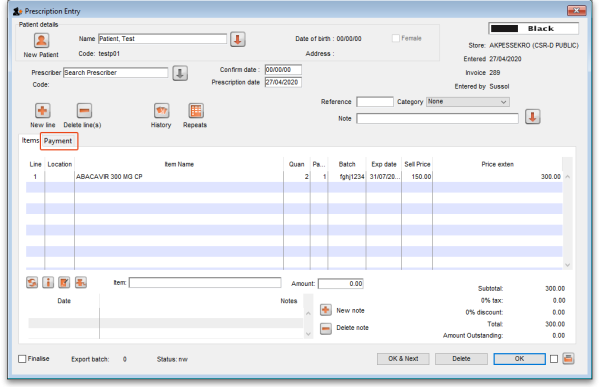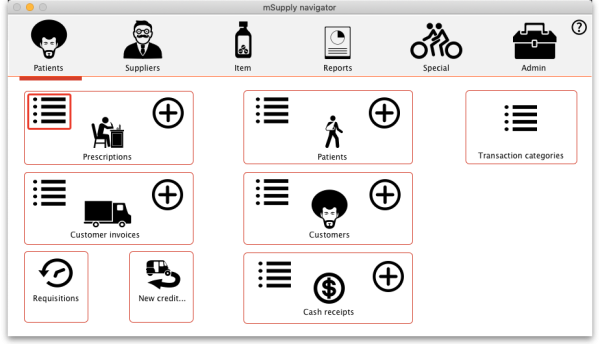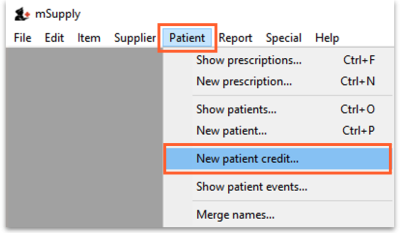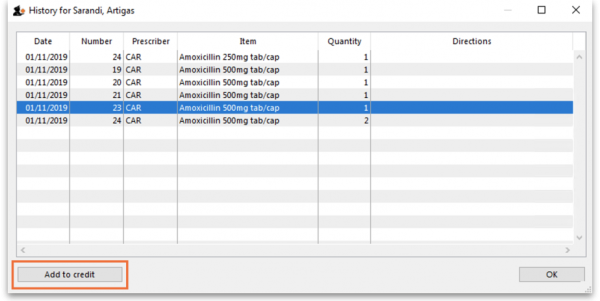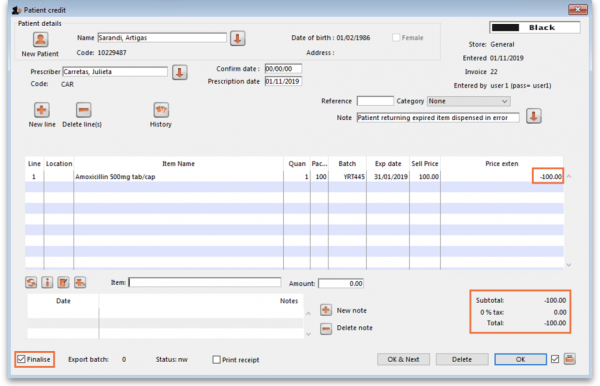11.03. Prescription payments and credits
Prescription payment preferences
To receive payments for prescriptions in a dispensary, go to Dispensary Mode Preferences and check the Receive payments from prescription window box.
Once activated, a Payment tab will appear in the Prescription Entry window:
Entering the payment
To enter a payment from the Prescription Entry window:
1. Click on the Payment tab.
2. The Total payment field shows the amount that needs to be paid by the patient. Enter the amount the patient actually gives you in the Amount given field, then press the Tab key on the keyboard:
3. In this example, the prescription cost is $300 and the patient will pay with a $500 note, so 500 is entered in the Amount given field and the Tab key pressed. mSupply then shows you the change that is to be given back to the patient in the Change to give back field:
If payment types have been set up, then you can select the type of payment being made in the Payment type drop down list.
Please note: You cannot overpay a prescription. If you edit the Amount given field to be more than the Total payment amount the Amount given field will be reduced to the Total payment amount and the Change to give back will be increased by the difference.
4. Click OK to finalise the prescription and payment and close the window (if a payment is entered the prescription will be automatically finalised, you have no choice). If the Print receipt checkbox is checked then a payment receipt will print at this point.
Once you click OK, the prescription and payment are finalised and can no longer be edited. Check carefully before pressing OK!
Please note: You can save a prescription without a payment when the Receive payments from prescription window preference is turned on (see the top of this page) but the prescription will not be finalised, it will only be confirmed. You will be warned and asked to confirm that this is what you want to do if you do not enter a payment. If you want to enter the prescription payment later, you can find the prescription, open it and enter the payment then.
Paying with credit
Patients can be given a credit limit (see 10.03. Patients) and can use some or all of that credit at any time to pay off some or all of a prescription. Patient credits (see below) and cash paid into the cash register by a patient (see the 11.04. Cash register page for details) will add to the amount of credit a patient can use.
The process of using credit in a payment is exactly the same as the payment process described above, the only difference is that, if the patient has some credit available, mSupply will automatically use as much as it can to pay for the patient's prescription. You can see the amount of credit the patient has available (made up of their credit limit, patient credits and cash they have paid in) in the Patient's credit status section and the amount of credit used to pay for the prescription in the Amount paid by credit field:
In this example, the patient has 100 credit available (made up of their credit limit only, which is 100) and all of that credit has been used to pay the prescription charge.
If you or the patient does not wish to use their credit, or wishes to reduce the amount of their credit used to pay the prescription, simply change the amount of credit used in the Amount paid by credit field and press the Tab key on the keyboard so that mSupply re-calculates the amount to be paid by the patient. Here is a screenshot if the patient in the example above decides to pay 250 towards their prescription and only use 50 of their credit:
Patient credits
You can allocate funds in a patient's favour by giving them a Patient Credit. You might need to do this if, for example, a patient returns faulty medicines they already paid for. Creating a patient credit increases the amount of credit a patient has. Patient credit can be used to pay for future prescriptions.
View patient credits
To view already created patient credits, choose Patient > Show prescriptions in the menus or click on the show prescriptions icon on the Patients tab of the Navigator:
In the filter window that appears, select the appropriate filter options and click on the Find button to show the prescriptions that match the filters (just click on the Find button without changing nything if you want to see the default 15 most recent prescriptions):
Patient credits have cc (for “customer credit”) in the Type column, prescriptions have a type of ci. Iy you only wish to see patient credits then click on the Customer credits item on the left hand side.
Create patient credits
To create a new patient credit:
1. In the menus, choose Patient > New patient credit…:
2. Enter the patient in the Name field just as you would for a prescription. You can also enter other details such as a Reference (e.g. the prescription number this patient credit is related to) and a Note explaining why a patient credit is being issued.
3. Click the History button to view the items previously dispensed to this patient:
4. Select the item(s) to be returned from the patient's dispensing history, then click Add to credit. Multiple items may be added at once:
5. Review the patient credit. Note that the price appears as a negative value in the patient credit window since it is a credit to the patient, not a charge.
You can also add items not linked to a patient's history by clicking the New line button and entering item details just like you would for a prescription.
If you only want to allow users to issue patient credits for items linked to a patient's history, turn on the Limit patient credits to previously prescribed items preference in the Invoices 2 tab of File > Preferences (see Invoices 2 Preferences). This will disable the New line button, and all items must be selected from the History button.
6. Once you are sure the patient credit is correct, check the Finalise box and click OK.
Remember you have also just returned items to your mSupply inventory! If you are going to destroy returned items, you now need to remove them from your mSupply inventory in a separate transaction (either a Reduce stock Inventory Adjustment or a Stocktake).
When the patient pays for their next prescription, their credit will be automatically applied in the Payment window.
In this example, the patient's current prescription is $300 but they had a $100 credit which is automatically applied to the invoice. Now, they only need to pay $200.
Cancellations for prescription payments
When a prescription is cancelled, any payment made against it is not automatically cancelled because the patient might give you the goods back but not receive a cash refund. However, a patient credit is automatically created equal to the amount of the payment and assigned to the patient. This means the patient is refunded in credit, not cash.
If you really wish to refund cash to the patient, you need to find the patient credit created for them, cancel it and then go to the cash register and enter a cash out transaction for the patient. This will appear as a “ps” type transaction in the register. It is a good idea to have a separate payment type Option (16.10. Options (standard reasons)) for this type of cash out payment to allow you to report on them separately from other types of cash out transactions.
| Previous: 11.02. Receiving payment from customers | | Next: 11.04. Cash register |
